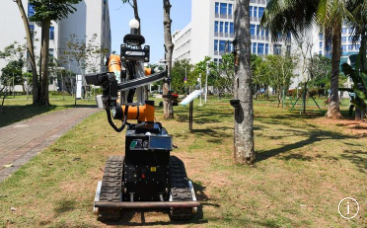
HAIKOU, March 24 (Xinhua) -- In a bid to tackle the chronic labor shortages plaguing its natural rubber industry, China has unveiled a mobile rubber-tapping robot, marking a leap forward in agricultural automation.
Developed jointly by the Chinese Academy of Tropical Agricultural Sciences (CATAS) and Beijing-based tech firm Automotive Walking Technology, the self-navigating robot is set to undergo trials in rubber plantations in south China's Hainan Province during the upcoming tapping season in April.
In a demonstration video, the robot can be seen approaching a rubber tree, before halting with pinpoint accuracy and then extending its robotic arm to execute a precise cutting motion on the trunk. Within seconds after this cutting motion, the video reveals milky-white latex flowing steadily from the incision made by the robot.
China's natural rubber sector, vital for tire manufacturing and as a source of industrial supplies, is currently facing a significant workforce deficit due to its grueling working conditions, nocturnal shifts and high incidence of occupational diseases.
"The rubber-tapping robots have been developed to address the exodus of rubber tappers, which is the industry's critical pain point," said Cao Jianhua, deputy director of the CATAS rubber research institute.
The robot, equipped with a multi-degree-of-freedom robotic arm and caterpillar-track mobility, leverages AI-driven technologies to adapt to complex terrain and perform precision cuts.
Its navigation system combines laser radar and multi-sensor fusion algorithms, enabling high-precision positioning in dense plantations. Also, visual tech determines tree bark depth and cutting angles, achieving 80 percent manual harvesting efficiency with matching latex quality.
The rubber-tapping robot can harvest 100 to 120 trees per hour, powered by lithium batteries that provide over 8 hours of continuous operation. Notably, its 20-second rapid battery swap capability ensures uninterrupted workflow in large plantations.
Once in the mass-production phase, the cost of the rubber-tapping robot will drop below 100,000 yuan (13,820 U.S. dollars), and for a 50-mu (3.33 hectares) rubber garden, robot-based tapping will recoup the purchase cost within about 18 months, Sun Yao, co-founder of Automotive Walking Technology, told Xinhua.
"We've been in discussions with several multinational tire companies and rubber growers throughout Southeast Asia, including in Indonesia and Thailand, and they're showing strong interest in our product," said Cao.
Cao's team is continuing to refine its technology. Soon, users will be able to monitor the robots directly from their smartphones, get a clear picture of the rubber garden's status, and use more big data and AI technologies for fully automated management.








 琼ICP备11000394号
琼ICP备11000394号 琼公网安备 46010602000325号
琼公网安备 46010602000325号